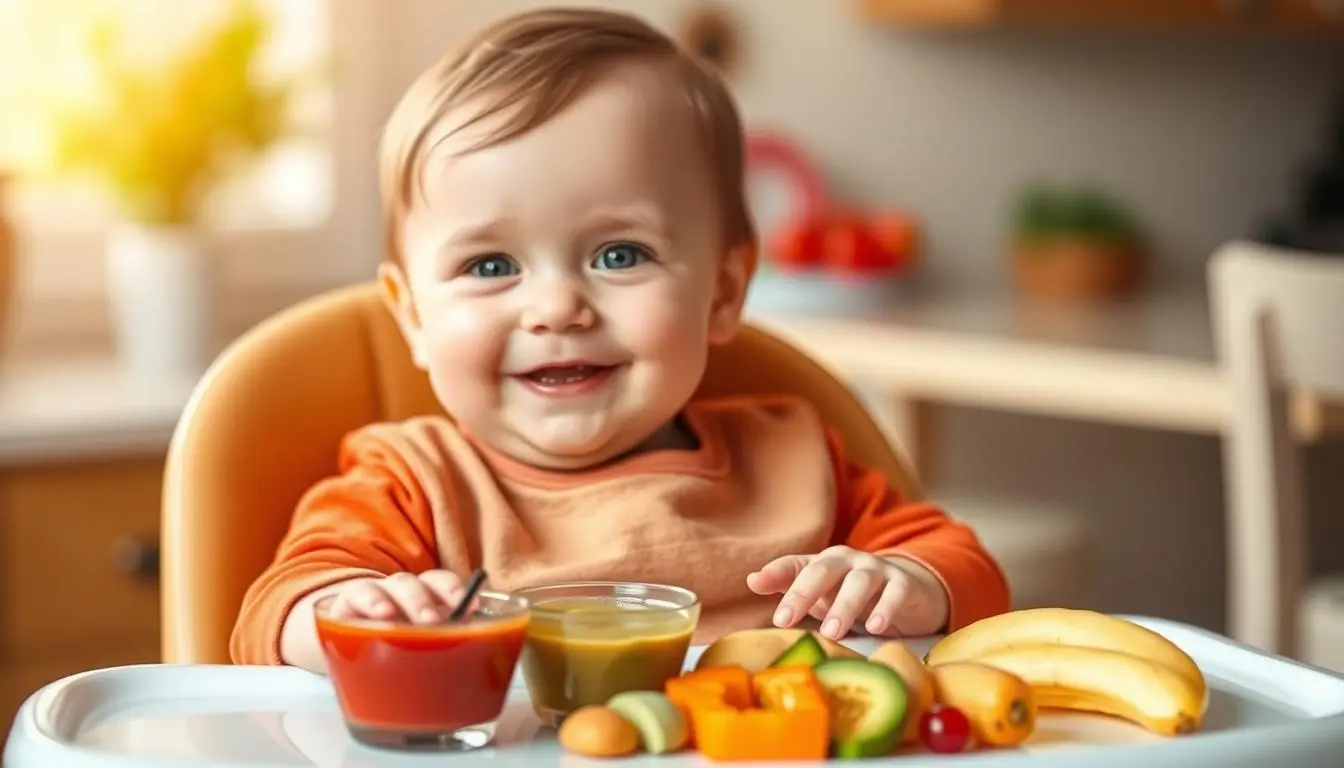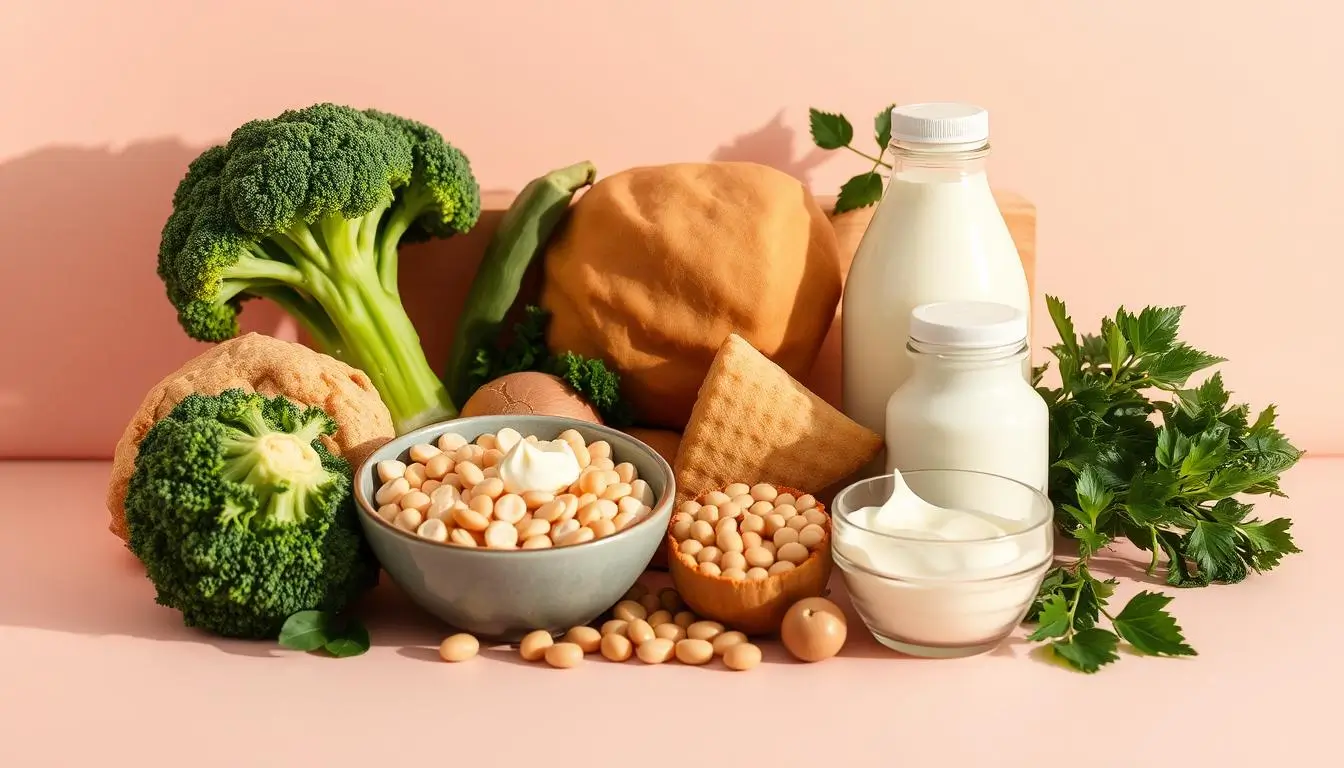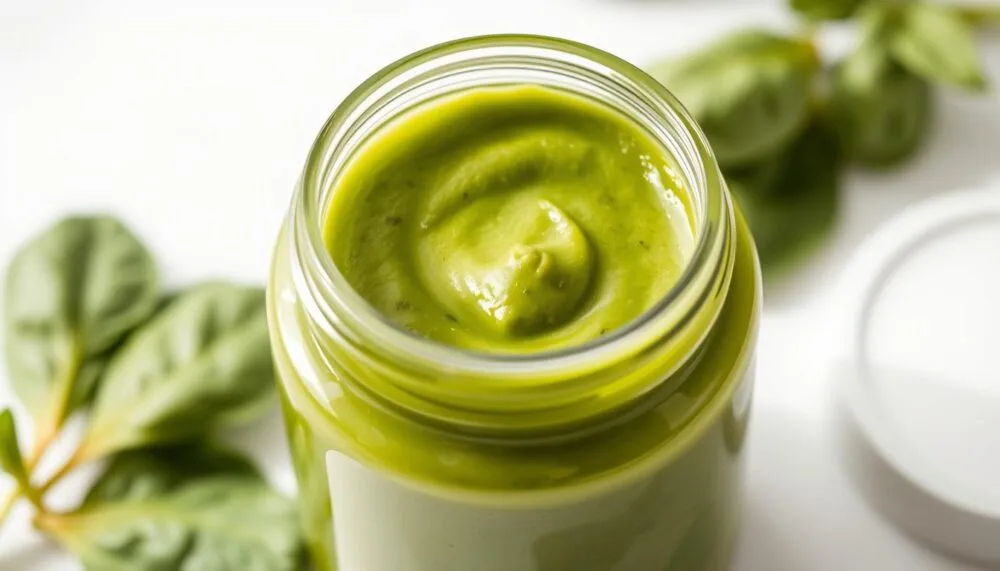Chicken baby food recipes for 6 month old babies are a great way to introduce protein into your little one’s diet. 🐣 Packed with nutrients and easy to digest, these simple purees are perfect for tiny tummies. Discover easy, homemade chicken recipes your baby will love! Starting your 6-month-old baby on solid foods is a big step. Chicken is a great first food because it’s full of protein and tastes mild.

Chicken baby food recipes are not only good for your baby. They’re also simple to make. They give your baby the nutrients they need to grow.
Key Takeaways
- Chicken is a nutritious first food for 6-month-old babies.
- It’s rich in protein and has a mild flavor.
- Chicken baby food recipes are easy to prepare.
- They provide essential nutrients for baby’s growth.
- Parents can introduce chicken in various forms.
The Benefits of Introducing Chicken to Your 6-Month-Old
At six months, babies need more than just milk. Chicken is a great addition to their diet. It’s full of nutrients that help them grow and develop.

Essential Nutrients in Chicken for Growing Babies
Chicken is packed with protein, vitamins, and minerals. These are key for a baby’s growth. It has niacin, vitamin B6, and selenium. These help with energy and keeping the immune system strong.
| Nutrient | Benefit |
|---|---|
| Protein | Builds and repairs muscles, organs, and tissues |
| Niacin | Supports energy production and skin health |
| Vitamin B6 | Essential for brain development and immune function |
| Selenium | Acts as an antioxidant, protecting cells from damage |
Developmental Advantages of Early Protein Introduction
Starting with protein-rich foods like chicken is good for babies. It helps build strong muscles and bones. It also supports overall growth and brain development.
Early protein helps keep a healthy weight and boosts the immune system. As babies get older, they need more protein. Chicken is a perfect choice for their diet.
Chicken Baby Food Recipes for 6 Month Old: Getting Started
Starting with chicken baby food recipes for your 6-month-old is exciting. But, it’s key to know the basics first. You need to focus on the right texture, quality, and safety.
Kitchen Tools You’ll Need for Homemade Baby Food
First, gather the right kitchen tools. A blender or food processor is essential for pureeing chicken. You’ll also need a steamer basket to cook chicken and veggies without losing nutrients. Don’t forget ice cube trays for portioning and airtight containers for leftovers.

Selecting High-Quality Chicken for Baby’s First Bites
Choosing the right chicken is critical for your baby’s health. Go for boneless, skinless chicken breast or thighs. They’re easier to puree and safer. Make sure the chicken is fresh and handled well to avoid contamination. Buying from local farms or reputable suppliers is best.
Organic vs. Conventional: Making the Best Choice
Parents often wonder between organic and conventional chicken for baby food. Organic chicken is raised without antibiotics and hormones. But, conventional chicken can be cheaper and healthy if from good farms. The most important thing is to pick chicken that’s fresh and handled safely.
| Considerations | Organic Chicken | Conventional Chicken |
|---|---|---|
| Antibiotics and Hormones | No antibiotics or hormones used | May contain antibiotics or hormones |
| Cost | Generally more expensive | More affordable |
| Availability | Widely available in health food stores | Commonly found in most supermarkets |
Safe Preparation Methods for Baby’s First Chicken Meals
When you start giving chicken to your 6-month-old baby, it’s important to do it safely. This means cooking it right and storing it well after it’s cooked. These steps help avoid foodborne illnesses.
Proper Cooking Temperatures and Food Safety Guidelines
Cooking chicken to the right temperature is key to keeping it safe. The temperature should be 165°F (74°C). Always use a food thermometer to check this, which is very important when cooking for your baby. Also, keep everything clean by washing your hands before and after touching raw chicken. Make sure all utensils and surfaces are clean too.
- Always thaw frozen chicken in the refrigerator or in cold water, changing the water every 30 minutes.
- Cook chicken immediately after thawing.
- Never refreeze thawed chicken without cooking it first.
Achieving the Perfect Consistency for 6-Month-Olds
Getting the right consistency is important for your baby’s first chicken meals. For 6-month-olds, the chicken should be smooth. You can make it smooth by blending cooked chicken with a little breast milk, formula, or water. As your baby gets used to eating solids, you can adjust the consistency.
When to Avoid Seasonings and Additives
For babies under 12 months, it’s best to avoid adding seasonings and additives to their food. This includes salt and sugar. Babies’ kidneys are not fully developed, and too much salt can be harmful. Also, introducing strong flavors early can affect their eating habits. So, it’s best to stick to plain, cooked chicken and let your baby enjoy its natural taste.
Basic Chicken Puree Recipes for Beginners
Starting your baby on chicken puree recipes is a healthy way to introduce new flavors. Chicken is full of protein, which is key for your baby’s growth. Here are some easy recipes to start with.
Simple Chicken Breast Puree
You’ll need 1 boneless, skinless chicken breast, cooked and diced, and 2 tablespoons of breast milk or water. Blend until it’s smooth. This is a great first step in introducing chicken to your baby.
Chicken and Apple Combination
Combine 1/2 cup of cooked chicken breast with 1/2 cup of cooked apple. Blend until it’s smooth. The apple adds sweetness, making it a tasty first food.
Chicken with Sweet Potato Blend
Mix 1/2 cup of cooked chicken with 1/2 cup of cooked sweet potato. Blend until smooth. Sweet potatoes are full of vitamins and minerals, which go well with chicken.
Creamy Chicken and Avocado Puree
Blend 1/2 cup of cooked chicken breast with 1/4 avocado. The avocado makes it creamy and adds healthy fats. This is a great way to introduce healthy fats to your baby’s diet.
| Recipe | Main Ingredients | Benefits |
|---|---|---|
| Simple Chicken Breast Puree | Chicken breast, breast milk or water | High in protein, easy to digest |
| Chicken and Apple Combination | Chicken breast, apple | Adds natural sweetness, rich in fiber |
| Chicken with Sweet Potato Blend | Chicken breast, sweet potato | Rich in vitamins and minerals, high in fiber |
| Creamy Chicken and Avocado Puree | Chicken breast, avocado | High in healthy fats, creamy texture |
These recipes are simple, nutritious, and easy to make. Make sure the chicken is cooked well to avoid foodborne illness. As you get more comfortable, you can try different ingredients and flavors.
Nutritious Vegetable and Chicken Combinations
Chicken and vegetables are great for 6-month-old babies. They help with growth and development. Mixing chicken with different veggies makes a healthy meal.
Iron-Boosting Chicken with Spinach Puree
Chicken and spinach make a puree full of iron. Iron is key for healthy red blood cells and brain growth. Cook chicken, then blend it with spinach and a bit of water.
Vitamin-Rich Chicken with Carrots and Peas
Carrots and peas are full of vitamins A and C. They boost a baby’s immune system. Cook chicken with these veggies for a tasty, healthy meal.
Antioxidant-Packed Chicken with Butternut Squash
Butternut squash adds antioxidants and fiber to chicken purees. These help protect cells and aid digestion. Cook chicken and squash, then blend until smooth.
Calcium-Enhanced Chicken with Broccoli
Broccoli is rich in calcium, important for strong bones and teeth. Mixing it with chicken makes a calcium-rich meal. Steam broccoli, then blend with chicken for a nutritious puree.
| Recipe | Key Nutrients | Benefits |
|---|---|---|
| Chicken with Spinach Puree | Iron | Supports healthy red blood cells and brain development |
| Chicken with Carrots and Peas | Vitamins A and C | Boosts immune system and overall health |
| Chicken with Butternut Squash | Antioxidants, Fiber | Protects cells from damage, supports healthy digestion |
| Chicken with Broccoli | Calcium | Builds strong bones and teeth |
Introducing Mild Flavors and Textures to Chicken Dishes
Introducing mild flavors and textures to chicken dishes is a great way to encourage healthy eating habits in your six-month-old. As babies grow, they can try different flavors and textures. This makes mealtime more fun and helps them discover new tastes.
Baby-Safe Herbs and Spices for Chicken Recipes
When adding new flavors to your baby’s chicken, use safe herbs and spices. Options like parsley, basil, and cilantro add freshness without being too strong. “Introducing various herbs and spices can make babies more adventurous eaters,” says Dr. Jane Smith, a pediatric nutrition expert.
Transitioning from Smooth to Slightly Textured Purees
As your baby gets used to solid foods, try slightly textured purees. You can mash cooked chicken with a fork or blend it to a thicker consistency. This helps babies practice chewing and prepares them for more solid foods.
Chicken with Mild Herbs Recipe Collection
Here are a few simple recipes to get you started:
- Chicken and Parsley Puree: Mix cooked chicken breast with fresh parsley and a squeeze of lemon juice.
- Basil Chicken Mash: Blend cooked chicken with fresh basil leaves and a drizzle of olive oil.
- Cilantro Lime Chicken: Combine cooked chicken with chopped cilantro, lime juice, and a hint of salt.
These recipes are not only delicious but also full of nutrients. They are great for your baby’s growth and development.
By introducing mild flavors and textures, you’re helping your baby develop a more adventurous palate. This can lead to a healthier relationship with food. Always check with your pediatrician before making any big changes to your baby’s diet.
Meal Planning and Storage Solutions for Busy Parents
Busy parents often find it hard to manage mealtime. Having good meal planning and storage can help a lot. It’s key when introducing new foods like chicken to a six-month-old baby.
Batch Cooking Strategies for Weekly Meal Prep
Batch cooking is a big help for parents. It lets you make a lot of chicken puree at once. Then, you can portion it out for the week. This saves a lot of time.
Proper Freezing and Storage Techniques
Freezing baby food right is important. Use airtight containers or freezer-safe bags to keep it fresh. Don’t forget to label them with the date and what’s inside. Chicken puree can stay frozen for up to three months.
Safe Thawing and Reheating Practices
Thaw frozen chicken puree in the fridge or cold water. Always reheat it to 165°F (74°C) for safety. Check the temperature and texture before serving to your baby.
Addressing Common Questions About Chicken for 6-Month-Olds
Introducing chicken to a 6-month-old baby’s diet can be a bit daunting. Many parents have questions about its safety and preparation. Chicken is nutritious and rich in protein, making it a great addition to a baby’s diet. But, it’s important to address common concerns.
Can Babies Eat Chicken at Six Months?
Yes, babies can eat chicken at six months. Chicken is a good source of protein. This is important for a baby’s growth and development. At six months, babies need more protein than breast milk or formula alone.
How to Cook Chicken for a 6-Month-Old Baby
Cooking chicken for a 6-month-old involves ensuring it’s thoroughly cooked. This is to avoid foodborne illnesses. Steam or bake chicken breast until it’s soft and easily mashed with a fork. Then, puree it to a smooth consistency suitable for your baby’s age.
Is Pureed Chicken Safe for 6-Month-Olds?
Pureed chicken is safe for 6-month-olds when prepared correctly. Ensure the chicken is cooked thoroughly and pureed to a smooth consistency. This reduces the risk of choking. You can also mix it with other foods like fruits or vegetables to create a nutritious meal.
Signs of Allergic Reactions to Watch For
When introducing chicken to your baby’s diet, watch for signs of an allergic reaction. Look for rash, itching, swelling, vomiting, or diarrhea. If you notice any of these symptoms, consult your pediatrician for advice.
Conclusion
Introducing chicken to your 6-month-old baby is a great way to provide essential nutrients for their growth and development. This article has covered various aspects of preparing chicken baby food recipes for 6 month old, from basic recipes to meal planning and safety guidelines.
By following the information and recipes provided, parents can confidently introduce chicken into their baby’s diet, ensuring they receive the nutrients they need. Chicken baby food recipes for 6 month old can be simple and nutritious. With the right guidance, parents can create a variety of healthy meals for their babies.
As you start your baby’s journey with chicken, remember to always prioritize food safety and your baby’s unique needs. With patience and practice, you can help your baby develop healthy eating habits that will last a lifetime.
FAQ
Can babies eat chicken at six months?
Yes, babies can start eating chicken at six months. Chicken is a good first food because it’s high in protein and tastes mild. It’s perfect for introducing to babies around this age.
How to cook chicken for a 6-month-old baby?
To cook chicken for a 6-month-old, make sure it’s soft and tender. Use baking, boiling, or steaming to cook it. Always cook the chicken to 165°F (74°C) to avoid foodborne illnesses.
Is pureed chicken safe for 6-month-olds?
Yes, pureed chicken is safe for 6-month-olds if it’s cooked right. Make sure the chicken is fully cooked and pureed well. This helps prevent choking.
How do I feed my 6-month-old chicken?
Start with a small amount of pureed chicken for your 6-month-old. Gradually add more as they get used to it. You can mix it with fruits or veggies for a balanced meal.
Can I give my 6-month-old pureed chicken?
Yes, you can give your 6-month-old pureed chicken. It’s a nutritious and easy-to-digest food for babies at this age. Just make sure it’s prepared and cooked safely.
What are the signs of allergic reactions to chicken in babies?
Signs of an allergic reaction to chicken in babies include rash, itching, swelling, diarrhea, vomiting, or fussiness after eating. If you see these symptoms, talk to your pediatrician.












